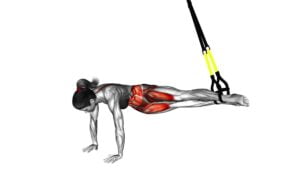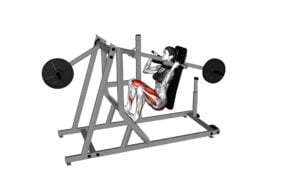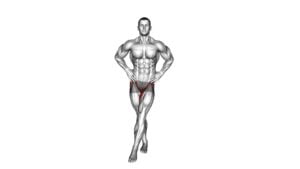Bent Over Shoulder Pendulum (female) – Video Exercise Guide & Tips

Get ready to strengthen and tone your shoulders with the Bent Over Shoulder Pendulum exercise.
Watch This Exercise Video
In this video exercise guide, we'll show you the proper form and technique to maximize your results. No fancy equipment is needed, making it easy to do at home or the gym.
Whether you're a beginner or more advanced, we've got modifications and tips to help you perfect your form and avoid common mistakes.
Ready to take your shoulder workout to the next level? Let's get started!
Key Takeaways
- Bent Over Shoulder Pendulum improves shoulder mobility and increases range of motion in the shoulders.
- Proper form and technique, including maintaining correct shoulder alignment and avoiding excessive momentum, are crucial for maximizing the exercise's effectiveness and preventing injury.
- Core stability and engagement are important for maintaining balance and control during the exercise.
- To improve range of motion, gradually increase resistance, focus on form and technique, and incorporate dynamic stretching exercises into warm-up routines.
Benefits of Bent Over Shoulder Pendulum
You will experience numerous benefits from incorporating the Bent Over Shoulder Pendulum exercise into your workout routine. This exercise is highly effective in improving shoulder mobility, as well as aiding in injury prevention and rehabilitation.
By performing the Bent Over Shoulder Pendulum exercise, you'll notice a significant improvement in your shoulder mobility. This exercise involves gently swinging your arms in a controlled manner, which helps to increase the range of motion in your shoulders. This increased mobility can be beneficial for athletes and individuals who perform activities that require a wide range of shoulder movement.
Furthermore, the Bent Over Shoulder Pendulum exercise is also effective in preventing and rehabilitating shoulder injuries. The controlled swinging motion helps to strengthen the muscles surrounding the shoulder joint, providing stability and support. This can help prevent injuries such as dislocations or strains. Additionally, if you're recovering from a shoulder injury, incorporating this exercise into your rehabilitation routine can aid in the healing process and restore strength and mobility to the injured area.
Incorporating the Bent Over Shoulder Pendulum exercise into your workout routine is a valuable addition for improved shoulder mobility, injury prevention, and rehabilitation. Take advantage of these benefits and start incorporating this exercise into your fitness regimen today.
Proper Form and Technique
When performing the Bent Over Shoulder Pendulum exercise, it's important to maintain correct shoulder alignment to prevent injury and optimize results. To achieve this, make sure to keep your shoulders relaxed and pulled back, avoiding any rounding or hunching of the upper back.
Additionally, be mindful of common mistakes such as using excessive momentum or swinging the body, as these can compromise the effectiveness of the exercise. By focusing on proper form and technique, you can improve your range of motion and maximize the benefits of the Bent Over Shoulder Pendulum.
Correct Shoulder Alignment
Achieve optimal shoulder alignment by maintaining proper form and technique while performing the Bent Over Shoulder Pendulum exercise. Shoulder mobility and stability are crucial for this exercise, as they help to prevent injuries and maximize the effectiveness of the movement.
Start by standing with your feet shoulder-width apart and your knees slightly bent. Bend forward at the waist, keeping your back straight and your core engaged. Let your arms hang down towards the floor, allowing them to swing back and forth in a pendulum-like motion.
As you swing your arms, focus on keeping your shoulders relaxed and in line with your body. Avoid shrugging or hunching your shoulders, as this can lead to unnecessary tension and strain. By maintaining correct shoulder alignment, you can improve your overall posture and enhance the benefits of the exercise.
Avoiding Common Mistakes
To ensure proper form and technique, it's important to focus on maintaining correct shoulder alignment during the Bent Over Shoulder Pendulum exercise. By doing so, you can avoid common mistakes and maximize your success with this exercise.
One common mistake to avoid is rounding your shoulders forward, which can put excessive strain on your neck and upper back. Instead, keep your shoulder blades pulled back and down throughout the movement.
Another mistake is using momentum to swing the weights, rather than engaging your shoulder muscles. Remember to move in a controlled manner, using the muscles in your shoulders to initiate the movement.
To further enhance your form and technique, start with lighter weights and gradually increase the resistance as you become more comfortable with the exercise.
Improving Range of Motion
Focus on increasing your range of motion by gradually increasing the resistance and engaging your shoulder muscles during the Bent Over Shoulder Pendulum exercise. This will help in increasing flexibility and enhancing joint mobility.
Here are some tips to improve your range of motion:
- Start with a light weight and gradually increase the resistance as your muscles become stronger.
- Focus on proper form and technique, ensuring that your shoulder muscles are engaged throughout the exercise.
- Incorporate dynamic stretching exercises into your warm-up routine to prepare your muscles for the movement.
- Perform regular stretching exercises, such as shoulder circles and arm swings, to improve flexibility and joint mobility.
Equipment Needed for the Exercise
You need equipment for the exercise. Using equipment can provide several benefits for the Bent Over Shoulder Pendulum exercise.
Firstly, it can help you maintain proper form and stability throughout the movement. Equipment such as dumbbells or kettlebells can add resistance, increasing the difficulty of the exercise and helping you build strength in your shoulders, back, and core.
Additionally, using equipment allows for different variations of the exercise, targeting different muscle groups and adding variety to your workout routine. For example, using a resistance band can provide constant tension throughout the movement, challenging your muscles in a different way. Alternatively, using a cable machine can allow for unilateral movements, helping to correct muscle imbalances and improve overall shoulder stability.
It's important to choose equipment that suits your fitness level and goals. Always start with lighter weights and gradually increase as you become more comfortable and confident with the exercise. Remember to consult with a fitness professional if you're unsure about the proper equipment and technique for this exercise.
Modifications for Beginners
If you're new to the Bent Over Shoulder Pendulum exercise, there are modifications available to help you ease into the movement and build strength gradually. These beginner modifications will allow you to perform the exercise safely and effectively.
Here are some options to consider:
- Start with a lighter weight: Using a lighter weight will reduce the strain on your muscles and joints, making it easier for you to maintain proper form and technique.
- Decrease the range of motion: Instead of swinging your arms all the way up and down, you can start by performing smaller swings. This will help you develop control and stability before progressing to a larger range of motion.
- Use a stability ball: Placing your chest on a stability ball while performing the exercise will provide additional support and stability. This modification is especially helpful if you have lower back issues or struggle with balance.
- Perform the exercise standing: If the bent-over position is too challenging for you, you can modify the exercise by performing it in a standing position. This will help you focus on the shoulder movement without putting as much stress on your back.
Common Mistakes to Avoid
To ensure proper execution of the Bent Over Shoulder Pendulum exercise, it's crucial to avoid the mistake of rushing through the movement. Proper breathing and maintaining core stability are key factors in performing this exercise correctly.
One common mistake to avoid is forgetting to breathe properly. It's essential to inhale deeply before starting the movement and exhale as you swing your arms from side to side. This rhythmic breathing helps to oxygenate your muscles and maintain control throughout the exercise.
Another mistake to avoid is neglecting your core stability. Your core muscles, including your abdominals and lower back, play a significant role in maintaining balance and control during the Bent Over Shoulder Pendulum. Engage your core by drawing your belly button towards your spine and keeping your back straight throughout the movement. This won't only enhance the effectiveness of the exercise but also help prevent injury.
Lastly, rushing through the movement is a common mistake that can compromise form and minimize the benefits of the exercise. To perform the Bent Over Shoulder Pendulum correctly, take your time and focus on the quality of the movement rather than the speed. Pay attention to your form, ensuring that your shoulders are relaxed, and your arms swing smoothly and controlled from side to side.
Tips for Progression and Variation
To progress and vary your Bent Over Shoulder Pendulum exercise, incorporate different weights or resistance bands. Here are some progression tips and variation ideas to help you get the most out of your workout:
- Increase the weight: Gradually increase the weight of the dumbbells or resistance bands to challenge your muscles and improve strength. This will help you continue to make progress and avoid hitting a plateau.
- Change the tempo: Experiment with different tempos during the exercise. Slow down the movement to increase time under tension and really work your muscles, or speed up the movement for a more dynamic and cardiovascular challenge.
- Try unilateral movements: Instead of using both arms simultaneously, try performing the exercise with one arm at a time. This will engage your core and stabilizer muscles to a greater extent, providing a more challenging workout.
- Incorporate balance elements: Stand on one leg while performing the exercise to challenge your balance and stability. This won't only work your shoulder muscles but also engage your core and lower body.
Frequently Asked Questions
How Many Repetitions and Sets Should I Do for the Bent Over Shoulder Pendulum Exercise?
For the bent over shoulder pendulum exercise, the number of repetitions and sets can vary based on your fitness level and goals. It's recommended to start with 2-3 sets of 8-12 repetitions. As you get stronger, you can increase the number of sets or repetitions.
It's important to use a weight that challenges you but still allows you to maintain proper form. Consult with a fitness professional for personalized guidance.
Can I Perform the Bent Over Shoulder Pendulum Exercise if I Have a Shoulder Injury?
If you have a shoulder injury, it's important to modify the bent over shoulder pendulum exercise. This exercise puts strain on the shoulder joint, so it may not be suitable for you.
Instead, consider alternative exercises that are shoulder-friendly, such as standing lateral raises or seated shoulder presses. These exercises can help strengthen your shoulders without aggravating your injury.
Always consult with a healthcare professional before attempting any new exercises with a shoulder injury.
Is the Bent Over Shoulder Pendulum Exercise Suitable for Both Men and Women?
Yes, the bent over shoulder pendulum exercise is suitable for both men and women. When it comes to exercise preferences, gender differences are minimal. However, modifications can be made based on individual fitness levels.
Beginners can start with lighter weights and focus on proper form. Advanced individuals can increase the weight and intensity. Remember to consult a fitness professional or trainer to ensure you're performing the exercise correctly and safely.
Can I Use Dumbbells or Resistance Bands Instead of a Barbell for This Exercise?
Yes, you can definitely use dumbbells or resistance bands instead of a barbell for the Bent Over Shoulder Pendulum exercise.
This allows for variations in equipment and can provide different levels of resistance.
Using alternative equipment for Bent Over Shoulder Pendulum can help target different muscle groups and add variety to your workout routine.
Just make sure to maintain proper form and technique when using different equipment to ensure optimal results and prevent injury.
How Often Should I Include the Bent Over Shoulder Pendulum Exercise in My Workout Routine?
To determine how often to include the bent over shoulder pendulum exercise in your workout routine, consider your fitness goals and current fitness level.
Start by incorporating the exercise 2-3 times a week and gradually increase the frequency as you progress.
This exercise targets the shoulders, upper back, and core muscles.
To modify the exercise, you can adjust the weight or resistance used or vary the range of motion.
Always ensure proper form to avoid injury and maximize benefits.
Conclusion
In conclusion, the bent over shoulder pendulum exercise is a beneficial movement that targets the shoulders and back muscles. By maintaining proper form and using the recommended equipment, individuals can effectively strengthen these areas.
Beginners can modify the exercise to suit their fitness level, while avoiding common mistakes. Progression and variation can be achieved by following the provided tips.
Incorporating this exercise into your routine can contribute to improved strength and overall fitness.

Author
Years ago, the spark of my life’s passion ignited in my mind the moment I stepped into the local gym for the first time. The inaugural bead of perspiration, the initial endeavor, the very first surge of endorphins, and a sense of pride that washed over me post-workout marked the beginning of my deep-seated interest in strength sports, fitness, and sports nutrition. This very curiosity blossomed rapidly into a profound fascination, propelling me to earn a Master’s degree in Physical Education from the Academy of Physical Education in Krakow, followed by a Sports Manager diploma from the Jagiellonian University. My journey of growth led me to gain more specialized qualifications, such as being a certified personal trainer with a focus on sports dietetics, a lifeguard, and an instructor for wellness and corrective gymnastics. Theoretical knowledge paired seamlessly with practical experience, reinforcing my belief that the transformation of individuals under my guidance was also a reflection of my personal growth. This belief holds true even today. Each day, I strive to push the boundaries and explore new realms. These realms gently elevate me to greater heights. The unique combination of passion for my field and the continuous quest for growth fuels my drive to break new ground.



